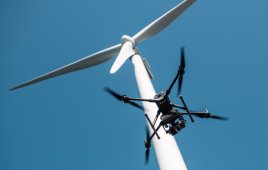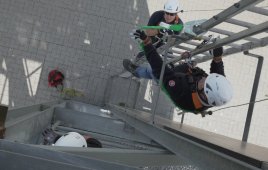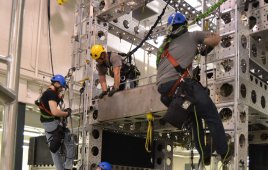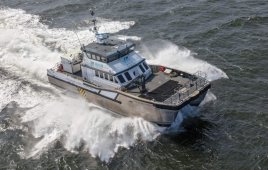Wind turbine towers are a natural target for lightning strikes. A good grounding system plays a critical role guarding against catastrophic damage to the blades, electronics, transformer, nacelle, and collector system out to the substation. Up until now, copper has been the predominant material in wire and cable used in the grounding of all manner of electrical systems. But the cost of copper fluctuates substantially and now regularly flirts with its all time high price reached back in mid 2008. This is not good news for wind-farm developers, and electrical and construction contractors who are under increasing pressure to control costs on these projects.

- The cross sections of Copper Clad Steel show several size variations. The conductor provides one way to trim turbine costs without sacrificing capability.One solution to the problem is in Copper Clad Steel (CCS). It is reliable, cost effective, and can provide the industry with a smarter alternative to copper based grounding systems.While the enthusiasm for adding wind energy to the national grid has the industry breaking records for increasing the country’s generation capacity, this does not mean there’s an open invitation to spend whatever it takes to build a new wind farm. The recent financial crisis has altered the trajectory of wind-farm projects by tightening developers’ budgets with a need to control costs, an increasing priority even as the industry expands.
Smart grounding
Given the cost sensitivity of any new wind-farm project in this environment, the idea of burying a precious metal underground makes no economic sense when less expensive, proven alternatives are readily available. Fortunately, CCS has been around for decades and is a practical option to consider in grounding applications. It offers a smart alternative to copper by combining the strength of steel with the conductivity of copper through a cladding process that delivers comparable performance and a long-term return on the investment.
Safety and regulatory
The first question one might ask is: What am I giving up by choosing CCS? Frankly, the answer is: Not much other than cost. CCS delivers the needed performance when lightning strikes. To demonstrate the effectiveness of CCS in lightning protection for wind turbines, CommScope had its product tested by an independent lab in Denmark in accordance with two proposed IEC standards:
• IEC 62305-1: Protection against lightning – Part 1: General principles, and
• IEC 61400-24 Ed. 1.0: Wind Turbines – Part 24: Lightning protection CDV
These standards, scheduled for release later this year and early next year establish general principles for lightning protection as well as define specific acceptable thresholds for wind turbines. The results of these tests clearly showed that the CCS exceeded the levels called for by IEC standards.
Reliability, durability, and flexibility
In addition to performance, CCS has the advantage of longevity, reliability, and durability that any project planner would appreciate. With steel at its core, for strength, and a durable, proven cladding process, CCS also provides the performance of copper by carrying the current along the outer skin (skin affect). This combination performs optimally when needed and is easier to work with than anticipated. In addition, CCS can be connected by any exothermic welding or compression connectors in common use today ensuring full capability and direct replacement to copper in grounding applications.
Electrical comparisons to solid copper
(Click on the table below to view larger image)
Companies making CCS provide the data that lets contractors make proper electrical comparisons to copper wire. Often 4/0 copper has been used in collector systems between turbines and out to the ground grid in the substations. Understanding the actual “fault currents” within the line and system lets designers select a CCS size appropriate to the fault current instead of just using the expensive yet commonly used 4/0 stranded copper. For example, some designers have reduced the size of the CCS conductor from 4/0 copper and saved even more on the ground conductor by “right sizing” the cable to the ground faults. Fusing-current tables below help decide which size CCS to use based on electrical performance and not just physical size.
A final word: Cost
The reference above to “right sizing” means matching CCS to the equivalent physical size of copper. Because of the slightly different properties, users can choose to replace copper with a smaller sized CCS cable that still has the electrical properties to handle the fault current in a grounding application. On a direct physical size comparison, CCS is less expensive than copper, hence, users can tally additional cost savings by going with a smaller size.
With the performance of CCS established through independent testing for lightning protection, the last detail becomes under-standing the cost issue. When looking at what’s happened to the price of copper over the past year, the cost argument is an easy one to make. With the price of all precious metals rising and becoming increasingly unstable, developers, project managers, contractors, and suppliers are nervous about the impact on the cost of their next project. While pricing does fluctuate, CCS savings can average 10% or more when compared to copper. This goes to the bottom line of any project. With copper pricing showing no signs of falling back to 2009 levels anytime soon, this is good news for those who have already taken advantages of CCS. WPE
(Click on the chart below for a larger version)
Filed Under: Safety







The main electrical feed, which was set up in a 120/240V, 3-phase, center-grounded delta configuration needed better protection from voltage surges on the utility service.